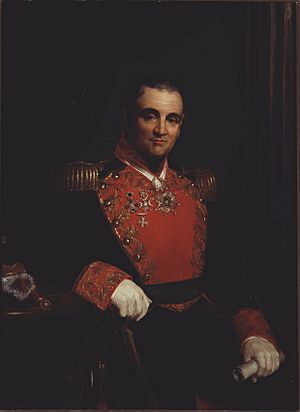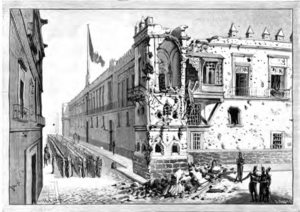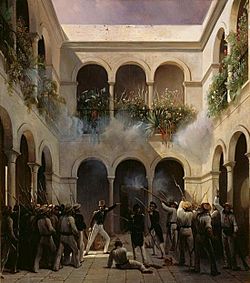Anastasio Bustamante facts for kids
Quick facts for kids
Anastasio Bustamante
|
|
|---|---|
 |
|
| 4th President of Mexico | |
| In office 1 January 1830 – 13 August 1832 |
|
| Vice President | Pedro Vélez |
| Preceded by | José María Bocanegra |
| Succeeded by | Melchor Múzquiz |
| In office 19 April 1837 – 20 March 1839 |
|
| Preceded by | José Justo Corro |
| Succeeded by | Antonio López de Santa Anna |
| In office 19 July 1839 – 22 September 1841 |
|
| Preceded by | Nicolás Bravo |
| Succeeded by | Francisco Javier Echeverría |
| 2nd Vice President of Mexico | |
| In office 11 June 1829 – 23 December 1832 |
|
| President | Vicente Guerrero José María Bocanegra Pedro Vélez Himself Melchor Múzquiz |
| Preceded by | Nicolás Bravo |
| Succeeded by | Pedro Vélez |
| Personal details | |
| Born |
Anastasio Bustamante y Oseguera
27 July 1780 Jiquilpan, New Spain |
| Died | 6 February 1853 (aged 72) San Miguel de Allende, Mexico |
| Nationality | |
| Political party | Conservative |
| Signature | |
Anastasio Bustamante y Oseguera (born July 27, 1780 – died February 6, 1853) was an important Mexican doctor, general, and politician. He served as president of Mexico three different times.
He first fought in the Mexican War of Independence for Spain. Later, he joined Agustín de Iturbide and supported the Plan of Iguala, which helped Mexico gain independence.
Bustamante was part of Mexico's first government after independence. After the First Mexican Empire ended, he was pardoned by President Guadalupe Victoria. In 1828, a confusing election led to him becoming vice president. Vicente Guerrero became president. Bustamante then led a coup d'état (a sudden takeover of the government) against Guerrero in 1829.
During his first time as president, he made some big changes. He sent away the U.S. Minister, Joel Roberts Poinsett. He also passed a law that stopped Americans from moving to Texas. His government even had extra money, which was rare. However, his opponents started a civil war in 1832, forcing him to leave Mexico.
He returned to Mexico in 1837 and became president again. During this time, Mexico had a conflict with France called the Pastry War. He also faced many rebellions. He was even taken hostage by rebels in 1840. Another revolt forced him into exile again in 1841. Bustamante came back in 1845 and helped during the Mexican–American War. He spent his last years in San Miguel de Allende and died in 1853.
Contents
Early Life and Education
Anastasio Bustamante was born on July 27, 1780. His family lived in Jiquilpan, Michoacán, Mexico. His father worked transporting snow to Guadalajara. Even though his family wasn't rich, Anastasio received a good education.
At age fifteen, he went to the Seminary College of Guadalajara. He later studied medicine in Mexico City. After finishing his studies, he became the director of a hospital in San Luis Potosí.
Bustamante also wanted to join the military. When Spain faced problems in 1808, he joined a cavalry group. But he didn't fully leave his doctor's job until the Mexican War of Independence began in 1810. At first, he fought for Spain.
Military Career
Fighting for Independence
Bustamante was promoted to captain in 1812. He fought in important battles like the Siege of Cuautla. He also helped stop an invasion led by Javier Mina.
He captured the Fort of Remedios, even though he was wounded. He also helped bring peace to the Guanajuato area.
Towards the end of the war, he was asked to join Agustín de Iturbide and his Plan of Iguala. This plan aimed for Mexico's independence. Bustamante agreed and declared his support for independence on March 19, 1821.
Iturbide made Bustamante his second-in-command. Bustamante helped prepare for the siege of Mexico City. After Mexico gained independence, he was named a Field Marshall. He also became captain general of several important regions.
After the Empire
After the First Mexican Empire fell, Bustamante supported a federal system for Mexico. This meant states would have more power. However, his uprising was defeated. He was supposed to be sent away from Mexico, but this punishment never happened.
In the early years of the First Mexican Republic, Mexican politics were divided. The liberal Yorkino party and the conservative Escoses party were rivals. Bustamante joined the Yorkino party. President Victoria gave him command of the internal provinces. His job was to stop raids and protect Mexico's borders.
First Presidency
| First Presidency of Anastacio Bustamante | ||
|---|---|---|
| Office | Name | Term |
| Foreign and Interior Relations | Manuel Ortiz de la Torre | 1 Jan 1830 – 11 Jan 1830 |
| Lucas Alamán | 12 Jan 1830 – 20 May 1832 | |
| José María Ortiz-Monasterio | 21 May 1832 – 14 August 1832 | |
| Justice and Ecclesiastical Affairs | Joaquín de Iturbide | 1 Jan 1830 – 7 Jan 1830 |
| José Ignacio Espinosa | 8 Jan 1830 – 17 Aug 1830 | |
| Joaquín de Iturbide | 18 May 1832 – 14 Aug 1832 | |
| Treasury | Ildefonso Maniau | 1 Jan 1830 – 7 Jan 1830 |
| Rafael Mangino | 8 Jan 1830 – 14 Aug 1832 | |
| War and Marine | Francisco Moctezuma | 1 Jan 1830 – 13 Jan 1830 |
| José Antonio Facio | 14 Jan 1830 – 19 Jan 1830 | |
| José Cacho | 20 Jan 1832 – 14 Aug 1832 | |
In 1828, Bustamante was elected vice-president under Vicente Guerrero. President Guerrero had special powers in 1829 because of a Spanish invasion. He didn't give them up, which made many people unhappy.
A plan to overthrow Guerrero began, and Bustamante joined it. On December 4, 1829, Bustamante announced the Plan of Jalapa. This plan aimed to restore constitutional order. Guerrero left the capital to fight the rebels, but the rebellion spread. The government surrendered on December 22.
Bustamante officially became president on January 1, 1830. Congress agreed with the Plan of Jalapa. They declared Guerrero unfit to rule. So, Vice-President Bustamante became president.
On April 6, 1830, the government acted on the growing problem in Coahuila y Tejas. Many American settlers had moved there. This made it hard for Mexico to control the region. A law was passed to stop more foreigners from moving to Texas. It also enforced customs along the border. The American colonists, who had been living quite freely, were very annoyed by this law.
For the first time, Mexico celebrated its independence on September 27. This was to remember when Agustín de Iturbide's army entered Mexico City. This was in addition to the usual celebration on September 16.
On February 14, 1831, Vicente Guerrero was captured and executed. He was one of Mexico's independence heroes. His death shocked the nation.
After Guerrero's death, there was peace in Mexico for a while. Taxes and customs increased, and Mexico's finances improved. In 1832, Bustamante reported that states had extra money. The government also had enough funds to pay interest on its foreign debt.
However, many people were uneasy. The government was becoming more controlling. Freedom of speech was limited. The legislature and courts became less independent.
Plan of Veracruz
On January 2, 1832, soldiers in Veracruz rebelled. They accused the government ministers of acting like dictators. They demanded that the ministers be removed. Santa Anna joined this movement. He was known for being liberal and had supported Guerrero.
The government couldn't defeat Santa Anna. The rebellion spread to other states. These states now wanted Bustamante replaced with Manuel Gomez Pedraza. Pedraza had won the 1828 election but had to flee.
On August 6, the city of San Luis Potosí joined the rebellion. President Bustamante left his office to lead troops against the rebels. General Melchor Muzquiz became interim president.
Bustamante defeated the rebels in San Luis Potosí. But then, another general, Valencia, joined the revolution. This put Mexico City at risk. Bustamante marched back towards the capital. Meanwhile, Santa Anna defeated government forces in Veracruz. His army then moved towards Mexico City.
Santa Anna and Bustamante fought near Puebla. Santa Anna won. By this point, the government had lost control of most of the country. Bustamante decided to stop fighting. He negotiated a peace treaty, the Treaty of Zavaleta, on December 23, 1832. Manuel Gomez Pedraza became president. Bustamante was sent away to Europe in 1833.
Life in Europe
Bustamante spent his time in Europe traveling. He visited military places and attended lectures in Paris. He also visited medical collections, as he was a doctor. He learned to speak French well. As a former president, he met many important people.
In 1833, the liberal government that followed Bustamante was overthrown. Santa Anna, who had changed to the conservative side, helped create a new constitution. This new government, called the Centralist Republic of Mexico, gave more power to the central government. This led to many revolts.
With conservatives now in power, Bustamante was allowed to return to Mexico. He was very upset when Mexico lost Texas in 1836. The government invited him back to help fight against Texas.
Second Presidency
After Santa Anna's fall, Bustamante was the most important conservative leader. Congress offered him the presidency, and he accepted on April 12, 1837. He said he returned from his peaceful life in Europe to help Mexico. He wanted to fight for Texas but noted there wasn't enough money. He promised fair justice for everyone.
Soon after he became president, Spain officially recognized Mexico's independence. This was a big step for Mexico.
Minor revolts happened but were quickly stopped.
Pastry War
A serious problem arose with France. French citizens in Mexico had suffered damages during Mexico's civil wars. One claim came from a baker whose shop was looted. France demanded payment.
Talks failed in January 1838. French warships arrived in Veracruz in March. France then blocked Mexican ports. On November 27, the French began to bomb Veracruz. The fortress of San Juan de Ullua surrendered. Mexico declared war and expelled all French citizens.
On December 5, French troops landed in Veracruz. They captured forts and tried to arrest Santa Anna. Santa Anna was injured and lost a leg, which made him popular again. The French controlled Veracruz. Bustamante's cabinet resigned.
England also felt the effects of the French blockade. They sent ships to Veracruz. France didn't want a conflict with England. So, new negotiations began. An agreement was reached in April 1838. France left, and Mexico agreed to pay damages.
Third Presidency
| Third Presidency of Anastasio Bustamante | ||
|---|---|---|
| Office | Name | Term |
| Relations | Manuel Eduardo de Gorostiza | 19 Jul 1839 – 26 Jul 1839 |
| Juan de Dios Cañedo | 27 Jul 1839 – 5 Oct 1840 | |
| Jose Maria Monasterio | 6 Oct 1840 – 20 May 1841 | |
| Sebastian Camacho | 21 May 1841 – 22 Sep 1841 | |
| Interior | Jose Antonio Romero | 19 Jul 1839 – 26 Jul 1839 |
| Luis Gonzaga Cuevas | 27 Jul 1839 – 12 Jan 1840 | |
| Juan de Dios Cañedo | 12 Jan 1840 – 9 Feb 1840 | |
| Luis Gonzaga Cuevas | 10 Feb 1840 – 3 Aug 1840 | |
| Juan de Dios Cañedo | 4 Aug 1840 – 14 Sep 1840 | |
| José Mariano Marín | 15 Aug 1840 – 6 Dec 1840 | |
| José María Jimenez | 7 Dec 1840 – 22 Sep 1841 | |
| Treasury | Francisco María Lombardo | 19 Jul 1839 – 26 Jul 1839 |
| Francisco Javier Echeverría | 27 Jul 1839 – 23 Mar 1841 | |
| Manuel Maria Canseco | 24 Mar 1841 – 22 Sep 1841 | |
| José María Tornel | 19 Jul 1839 – 27 Jul 1839 | |
| Joaquín Velázquez de León | 28 Jul 1839 – 8 Aug 1839 | |
| War | Juan Almonte | 9 Aug 1839 – 22 Sep 1841 |
Bustamante returned to the capital on July 19, 1839. He faced criticism for his military campaigns. He defended himself by reminding people of his past victories.
Yucatán Breaks Away
Bustamante then faced a major problem: the state of Yucatán wanted to break away. People there were unhappy with taxes and military service. In May 1839, a revolt began. By June 1840, the entire Yucatán Peninsula was controlled by rebels. They declared themselves independent until Mexico restored a federal system. They even made an alliance with Texas.
Federalist Revolt of 1840
The success of Yucatán inspired other federalists. On July 15, 1840, General Urrea escaped from prison. He and his men broke into the National Palace. They surprised President Bustamante in his bedroom and took him prisoner.
Valentín Gómez Farías, a former liberal president, arrived to lead the revolt. Fighting broke out in the capital. Rebels controlled the area around the National Palace. Government forces prepared to attack. Cannonballs even hit the palace where Bustamante was held. The president, using his medical skills, helped an injured officer.
The fighting was a stalemate. Bustamante was released to try and negotiate. But talks failed, and the capital suffered twelve days of war. Many buildings were damaged, and people died. News arrived that Santa Anna was coming with reinforcements. To avoid more destruction, new negotiations started. An agreement was reached for a ceasefire, and the rebels were pardoned.
Bustamante's Final Overthrow

After the revolt, Bustamante's government still faced many challenges. Tabasco also tried to leave Mexico. The northern parts of the country faced raids from Native American groups. A new Texas navy was attacking Mexico. The country also had serious money problems, forcing the government to raise taxes.
In 1839, customs taxes were increased. But most of this money went to pay off old debts. In 1841, the government's expenses were much higher than its income. Most of the money went to the military. This left a huge debt.
The tax increases led to protests from Mexican business owners. Mariano Paredes, a military commander, joined the protests. He called for a new government. On August 8, 1841, he gathered troops and marched towards Mexico City. Santa Anna joined him.
In September, Bustamante resigned as president again to lead the troops himself. He tried to gain support by saying he would restore the federal system, but it didn't work. The rebels won. Bustamante officially gave up power on October 6, 1841, through the Estanzuela Accords. A military group then created a new plan for government. Santa Anna became the head of a temporary government.
Later Years
After being overthrown for the second time, Bustamante went to Europe again. When Santa Anna lost power in 1844, Bustamante returned to Mexico. He wanted to help his country as tensions grew with the United States.
Under President Paredes, Bustamante became a senator. He was also made president of the national constitutional assembly in June 1846.
He did not fight in major battles during the Mexican–American War. He was sent on a mission to California but couldn't make it due to money problems. He also helped stop a rebellion in Mazatlán. After the war, he helped stop another revolt led by Paredes. These victories were the last of his long military career.
Bustamante was against the Treaty of Guadalupe Hidalgo, which made Mexico lose half its land. But he said he would obey the government's decision.
After the war, Bustamante retired from politics. He lived in San Miguel de Allende. He spent his time talking with friends and sharing stories from his life. He died on February 6, 1853, at age seventy-two. He was buried in San Miguel de Allende. His heart was buried next to Iturbide's remains in the National Cathedral.
See Also
 In Spanish: Anastasio Bustamante para niños
In Spanish: Anastasio Bustamante para niños
Images for kids


